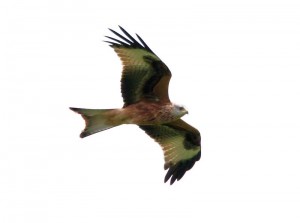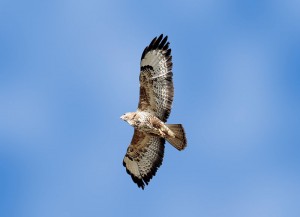 Botanists and entomologists spend a lot of time looking down.
Botanists and entomologists spend a lot of time looking down.
We birders spend a lot of time looking up – but my advice to a new birder would be to look up even more. And it’s so much more worthwhile than in the old days. There are more raptors up there.
I was in the bath a while ago and a shadow of an unseen, but large, bird passed across the window. It could, I thought, only have been a Red Kite, flying that low and being that big. And I had to check but the drenched bathroom floor was worth it for a sight of a gorgeous Red Kite over the back garden. A fairly common sight these days but none the less attractive for all that.
 And there are Buzzards too – almost never seen in east Northants when I moved here 30 years ago but now commonplace.
And there are Buzzards too – almost never seen in east Northants when I moved here 30 years ago but now commonplace.
What a lot of raptors you might say! But, not really.
Compared with the raptor numbers (both species and individuals) that can commonly be seen in many parts of Europe we still have a long way to go. These aren’t plagues of raptors – they are recoveries.
So, look up, and enjoy them as a sign of conservation progress.
There’s another aspect of looking up – it means you are holding your head high. And that’s what nature conservationists, particularly the RSPB, can do about their successes over the years.
[registration_form]
Amazing how well they do when we don’t kill them.
Driving around northern France and plenty of Buzzards to be seen near the Motorways, but also Kestrels, and how great to see them. Now, 20 years ago Kestrels were part of any drive up an English motorway but these days they seem rare as rocking horse ordure. In fact, in my experience Kestrels generally do not appear to be doing well despite the thousands of km of 6m margins being provided by Environmental Stewardship. Any thoughts folks?
I’ve read/heard somewhere that the increase in scrub etc. and decrease in tussocky grass areas along motorways could be causing a reduction in small mammals and hence prey for Kestrels. However that looks like, from the BTO records, for you the reduced numbers, if correct, are a local phenomenon. Maybe “your” kestrels have simple moved from where you used to see them to better hunting grounds?
Anecdotally, I’ve found kestrels pretty common in recent years, mostly in various northern England habitats but also some by main roads elsewhere. I agree perhaps fewer by busy motorways though. BTO’s Birdtrack ‘reporting rate’ graph for kestrel shows slightly above average reporting, compared to historical average, for first half of this year, then slightly below average to date.
The Red Kite is still a very rare sighting for my area, hopefully one day it will find its niche. Buzzards arrived 10 years ago and are still a delight to see and hear, they hammered the Magpie population in the first few years, A pair of Peregrines over winter in the town centre before leaving in spring to nest in the next town 7 miles away and we also have a pair of Ravens nesting in the town centre, thirty years ago I would have to have travelled 100 + miles to see all three birds mentioned in the same day. I dream of the day we get Goshawks in public parks like they do in Berlin and Merlin’s back on our local moors. The Merlin has the same breeding capacity as the Kestrel and the Sparrowhawk it is also very adaptable, the same questions being asked about Hen Harriers should also being asked about Merlins.
Jon, both Kestrels and Sparrowhawks change their behaviour when Buzzards are present to avoid being robbed of any prey they catch, keeping closer to cover